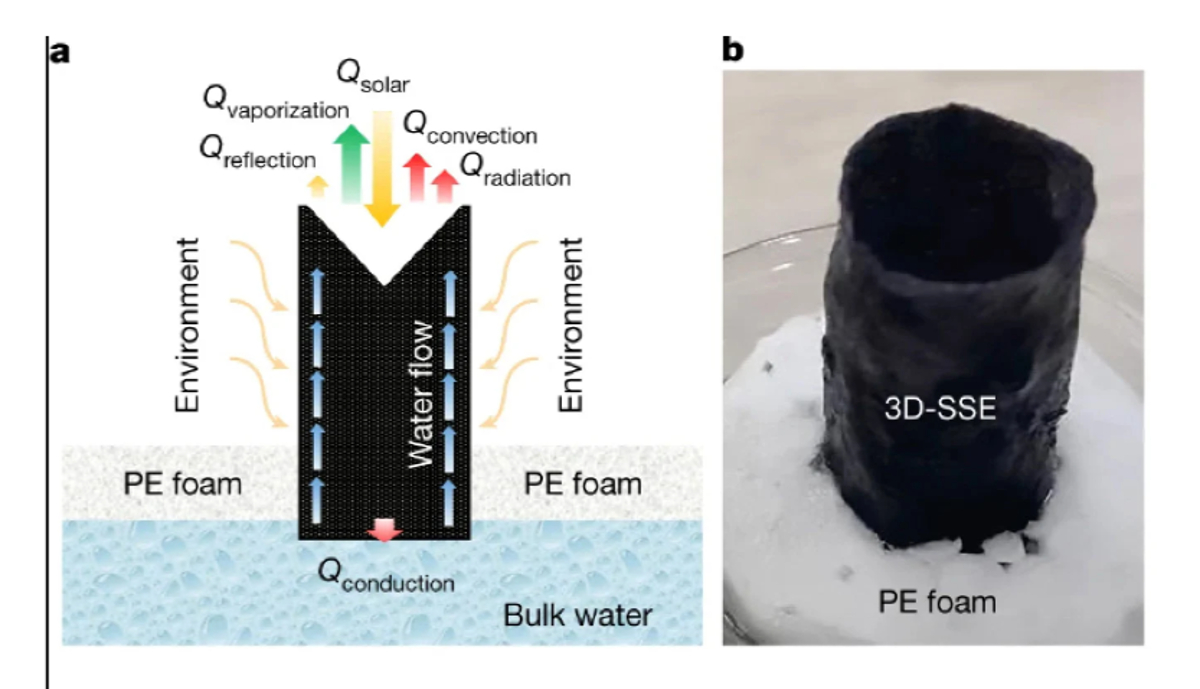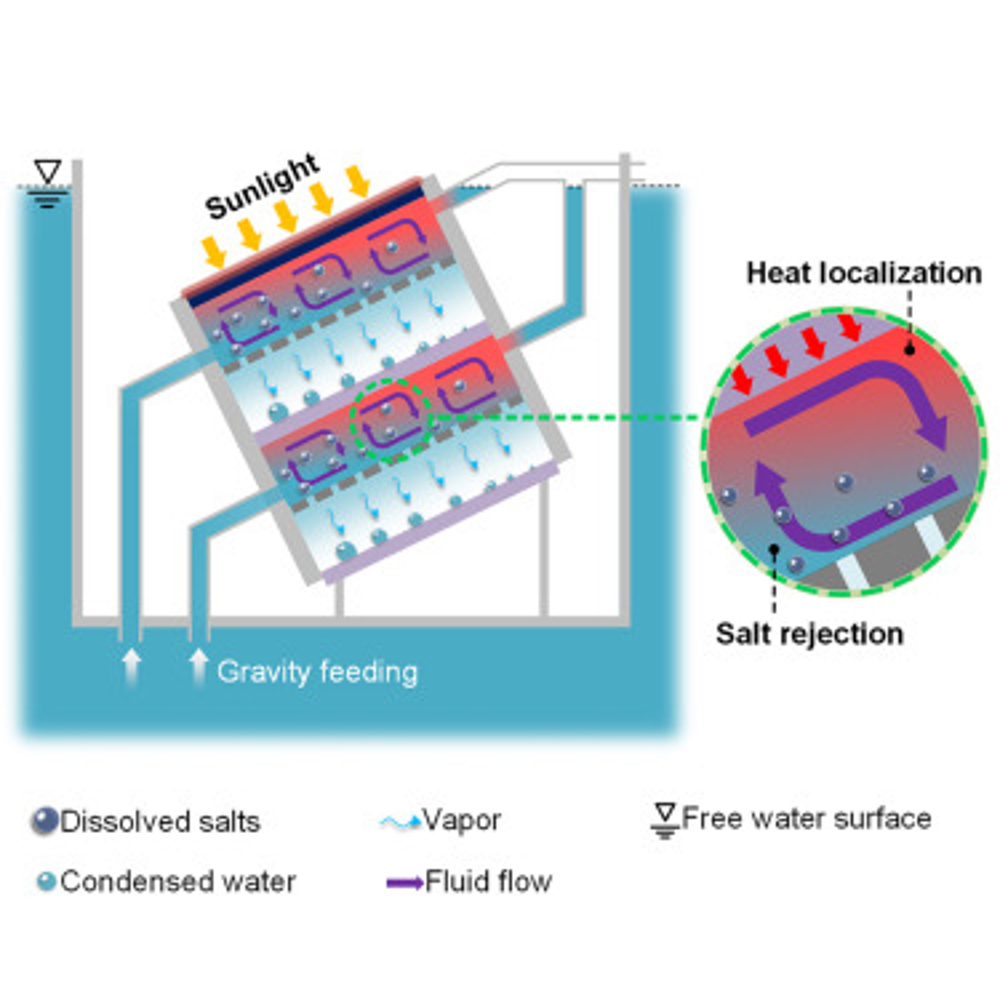Sign up for daily news updates from CleanTechnica on email. Or follow us on Google News!
A person can live about 3 minutes without oxygen and about 30 days without food, but only about 3 days without water. Water covers 71% of the surface of the Earth, but only 3% is the fresh water needed to support land-based beings and agriculture, and much of that is compromised by pollution. In theory, we can convert salt water to fresh water, but traditional desalinization techniques are expensive and require a lot of energy.
There are two stories about new desalinization systems rocketing around the internet this week that could make the process faster and less energy intensive using solar energy. Researchers in China say they using sunlight to squeeze the impurities out of seawater, while another group of scientists at MIT and Shanghai Jiao Tong University claim they can do the same but by a different route.
Solar-Powered Steam Desalinization

Photo credit: Nature via South China Morning Post
South China Morning Post reported on September 28, 2023, that a team of Chinese scientists at the Northeastern University in Liaoning province have set a record for desalinating water through solar steam evaporation. According to assistant professor and lead author Yang Bo, the new technology is “green and efficient” and capable of filtering more water per day than other similar methods.
[Note: SCMP says the study was published September 13 in the journal Nature, but did not provide a link to the study. Instead, it provided a link that leads back to the source article. A diligent search on Google and on the Nature website failed to find any reference to this study. It’s possible some intrepid CleanTechnica readers will succeed where I have failed. If so, please share that information in the comments section.]
The scientists used a new metallic titanium powder with a high solar absorption capacity and mixed it with other materials to create cylindrical evaporators. They were designed to minimize energy loss compared to flat evaporators and were able to achieve an evaporation rate of 6.09 kg (13.4 lb) per hour, according to the paper.
The evaporators absorb heat from sunlight, which turns the water into vapor and leaves the salt behind. The vapor then is moved to a cooler space where it condenses into purified water. The scientists say not only does their cylindrical device minimize energy losses, its larger surface area prevents the salt blockages that occur in other forms of solar steam desalination.
The team says their device is able to purify a record amount of fresh water — about 22 liters per square meter (0.54 per square foot) a day. That’s enough to meet the needs of 10 adults and “significantly higher” than other solar steam desalination methods.
Traditional desalination uses reverse osmosis to separate salt from seawater. To do this, water is passed through a porous membrane under pressure. The holes in the membrane are large enough to allow water molecules through, but small enough to block the impurities that make water salty. It’s an energy intensive process, which limits where the reverse osmosis units can be installed. According to the US Department of Energy, up to 40% of the cost of desalinated water is attributable to the energy needed to run the pumps to create that pressurize the source water. In addition, the membranes are expensive and need to be changed regularly.
Yang said the research provided “a new direction” for desalinating seawater that could effectively deal with water shortages while saving energy through its design.
Solar Powered Desalinization From MIT & SJTU
Researchers at MIT and Shanghai Jiao Tong University have come up with another solar powered desalinization device that truly is a marvel of creative engineering. Not only does it make about 5 liters of water per square meter per hour, it cleanses itself of salt buildup by borrowing from the same natural forces that power the world’s deep ocean currents. The research was published September 27, 2023 in the journal Joule. Here’s the summary:
“Recent advances in multistage solar distillation are promising for the sustainable supply of freshwater. However, significant performance degradation due to salt accumulation has posed a challenge for both long-term reliability of solar desalination and efficient treatment of hypersaline discharge.
Here, inspired by a natural phenomenon — thermohaline convection — we demonstrate a solar powered multistage membrane distillation with extreme salt resisting performance. Using a confined saline layer as an evaporator, we initiate strong thermohaline convection to mitigate salt accumulation and enhance heat transfer.
“With high freshwater production and extreme salt endurance, our device significantly reduces the water production cost, paving a pathway toward the practical adoption of passive solar desalination for sustainable water economy.”
The new system has a higher water production rate and a higher salt rejection rate than all other passive solar desalination concepts currently being tested. It relies on one or more of what the researchers call stages. Each stage contains an evaporator and a condenser that use heat from the sun to passively separate salt from incoming water.
A previous design proved effective at removing salt from water that was as much as seven times saltier than the ocean, but the salt left behind quickly clogged the system, meaning the stages needed to be replaced regularly. The cost of doing so made the system unsuitable for commercial purposes. A second prototype did a better job of disposing of the salt but suffered from reduced output of fresh water.
Now the researchers have found a way to combine the best features of both prototypes to create a system that can produce up to 60 liters of fresh water per solar day and discharge the accumulated salt in a way the allows it to function for years without routine maintenance, all without the need of circulation pumps that require electricity to operate.
“For the first time, it is possible for water, produced by sunlight, to be even cheaper than tap water,” says Lenan Zhang, a research scientist in MIT’s Device Research Laboratory. The team envisions a scaled-up device about the size of a suitcase could produce enough drinking water to meet the daily requirements of a small family. A larger system could supply off-grid coastal communities where seawater is easily accessible.
The latest design relies on the same principles that driver the world’s deep ocean currents. “When seawater is exposed to air, sunlight drives water to evaporate. Once water leaves the surface, salt remains. The higher the salt concentration, the denser the liquid, and this heavier water wants to flow downward,” Zhang explains.
“By mimicking this kilometer-wide phenomena in a small box, we can take advantage of this feature to reject salt. Zhenyuan Xu of Shanghai Jiao Tong University in China adds, “We have introduced now an even more powerful convection that is similar to what we typically see in the ocean.”
How It Works
Each stage in the latest system resembles a thin box topped with a dark material that efficiently absorbs the heat of the sun. The box is separated into a top and bottom section. Water can flow through the top half, where the ceiling is lined with a layer that uses heat from the sun to warm up and evaporate any water that comes into direct contact with it.
The water vapor is then funneled to the bottom half of the box where a condensing layer cools the vapor into salt free, drinkable liquid. The researchers set the entire box at an angle within a larger, empty vessel, then attached a tube from the top half of the box down through the bottom of the vessel, and floated the vessel in saltwater.
In this configuration, water can naturally push up through the tube and into the box, where the tilt of the box, combined with the thermal energy from the sun, induces the water to swirl as it flows through. The small eddies help to bring water in contact with the upper evaporating layer while keeping the salt circulating rather than settling out and clogging the system.
The team built several prototypes, with one, three, and 10 stages, and tested their performance in water of varying salinity. From these tests, the researchers calculated that if the system was scaled up to a square meter in size, it would produce up to 5 liters of drinking water per hour, and that the system could desalinate water without accumulating salt for several years.
“We show that this device is capable of achieving a long lifetime,” Zhong says. “That means that, for the first time, it is possible for drinking water produced by sunlight to be cheaper than tap water. This opens up the possibility for solar desalination to address real world problems.” For more about how the new system works, check out the video below.
The Takeaway
Fresh water is becoming harder to find. Lower river levels are allowing salt water from the oceans to flow upstream, endangering public water supplies in some coastal areas. On the other hand, agricultural runoff laden with phosphates and nitrates are threatening the water supplies of inland communities, something the solons on the US Supreme Court seem blissfully unaware of.
There is a good chance desalinization technologies will be needed in the near future to make enough fresh water for people, animals, and agriculture. Reverse osmosis is much too expensive for wide-scale relief. MIT researchers and their Chinese colleagues may have invented a process that will prove critical to human survival as the supply of potable fresh water gets smaller and smaller.
Have a tip for CleanTechnica? Want to advertise? Want to suggest a guest for our CleanTech Talk podcast? Contact us here.
EV Obsession Daily!
I don’t like paywalls. You don’t like paywalls. Who likes paywalls? Here at CleanTechnica, we implemented a limited paywall for a while, but it always felt wrong — and it was always tough to decide what we should put behind there. In theory, your most exclusive and best content goes behind a paywall. But then fewer people read it!! So, we’ve decided to completely nix paywalls here at CleanTechnica. But…
Thank you!
Tesla Sales in 2023, 2024, and 2030
CleanTechnica uses affiliate links. See our policy here.




